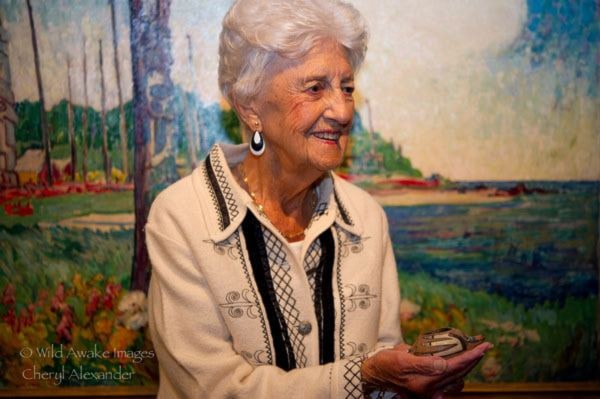In a life that has spanned a century, Ruth Squire has had a direct link to an early and now defunct Kootenay industry, raised a family through hard times, and encountered Emily Carr.
She is doubtless also the oldest surviving former resident of Nelson’s Kerr Apartments.
Still living in her own home in Victoria, she marked her 100th birthday Thursday with friends and neighbours, and on Saturday, family from across the country will join her at an open house.
Asked the secret to her longevity, she replies: “I don’t know. I’ve just lived a normal life.”
Her son Bruce suggests it’s “probably her disposition. She loves life. She’s a happy person. I’ve never heard her shout. She just didn’t do it.”
When she recently had her pacemaker checked, “they told me I have nine and a quarter years to go on the battery.”
She may well outlast it.
The ups and downs of the jam business
Squire was born in Nelson, the only child of Harry and Winifred Beach. Her father, who came from a family of jam makers in England, arrived here in 1909 to assume management of the Kootenay Jam Co. Ltd., a fledgling concern in what’s now the Front Street Emporium.
Her mother, who hailed from the Channel Islands, was a domestic servant for railway roadmaster Philip Wade and his wife Elizabeth. When the CPR transferred them from Owen Sound, Ont., to Nelson, she came along. (The Wade home at 619 Silica Street still stands.)
Soon after her parents married, Ruth’s maternal grandfather and aunt Nita came to live with them.
“He brought his furniture with him,” she marvels. “A Chippendale dining room suite!”
In 1911, the Kootenay Jam Co. sold its local operation to the Doukhobors and moved to Mission, but Harry Beach elected to stay behind and work for the newly-renamed Kootenay Columbia Preserving Works until it relocated to Brilliant four years later.
By that time, the Kootenay Jam Co. was going broke, and Beach moved his young family to Mission to assume control of the factory there under the name King-Beach Manufacturing Co.
While Ruth has no memory of Nelson, the 1915 civic directory shows the family lived in suite 104 of the Kerr Apartments, built the same year she was born.
Around the corner from Emily Carr
In 1922, the Beach family moved to Victoria, where Harry co-founded a new jam company, Beach Eakins Ltd., and Ruth began attending private school.
“I didn’t get much education till I was nearly ten,” she says. “My mother had gone to a convent in France, and in Mission there was just one school, where the Chinese went. My mother wouldn’t let me go to that school. I had three different governesses for an hour or so a day, and I could read and write, but school was hard.”
Her mother was by then gravely ill with tuberculosis, and died a few months later at 32.
Her father remarried, although relations with her new stepmother were strained.
From about 1927-31, they rented a house on St. Andrew Street, just around the corner from artist Emily Carr, and across the street from Carr’s sister.
Victoria’s most celebrated citizen was then still living in obscurity.
“She used to walk down our side of the street and cross to get to her sister’s,” Squire recalls. “I was afraid of her because of the way she looked... I used to cross the street so that I wouldn’t have to talk to her. I’m very sorry now. I wish I’d been kind and friendly.”
Squire’s father, however, would talk to Carr — and the monkey on her shoulder. In gratitude, she presented him with a small ceramic pot, telling him “he was the only man that would talk to her in the area.”
Her father kept the pot in a drawer for decades before giving it to Ruth’s husband. They showed it to guests occasionally and had it appraised at $500 to $600. A few years ago, Squire’s son suggested they donate it to an institution where it could be seen by the public.
Craigdarroch Castle graciously declined, but suggested they try the Victoria Art Gallery.
“Of course they were delighted,” Ruth says.
The pot was by now valued at $4,250.
In 1933, Ruth married Aubrey Squire, whom she met in church. Their son Brian was born that year, followed by Bruce in 1936. Ruth raised them by herself during World War II, while her husband was overseas. To make ends meet, she worked part-time at the Hudson’s Bay Co., and was later a receptionist at a doctor’s office.
Active mind and body
Today Squire remains spry, and keeps up with the news.
“She only has sight in one eye, but she’s a terrific reader,” her son says. “Mom likes to bake, but she’s getting a little tired of cooking.”
Bruce takes her grocery shopping, and if she feels up to it, “she takes the cart and I have trouble keeping up.”
Squire has only been back to Nelson once, with her aunt Nita, but they couldn’t find the home where they once lived. She also stayed in touch with the late Betty Engstad, a longtime Nelson teacher and granddaughter to the Wade family, whom Ruth’s mother worked for.
Ruth, who was predeceased by her husband in 1988 and son Brian in 2008, has six grandsons and ten great grandchildren.
